Understanding the Influence of Rock Content on Streaming Potential Phenomenon of Soil–Rock Mixture: An Experimental Study
Abstract
1. Introduction
2. Experimental Methodology
3. Results
3.1. Streaming Potential Phenomenon
3.2. Streaming Potential Coupling Coefficient with Different Rock Content
3.3. Effective Excess Charge Density and Rock Content
4. Discussion
4.1. Pressure Front and Potential
4.2. Influence of Rock Content on Permeability Coefficient
4.3. Influence of Rock Content on Streaming Potential Coupling Coefficient
5. Conclusions
- (1)
- The permeability coefficient of SRM first decreases and then increases with the increase in rock content. The value of minimum permeability coefficient is determined by material, compaction method and loading condition. The reference range of rock content for obtaining the minimum permeability coefficient is 30 to 50%. Our results still need many experiments to verify. Considering more groupings within the range of 30% to 50% rock content will be an effective method to determine the minimum permeability coefficient.
- (2)
- With the increase in rock content, the streaming potential coupling coefficient of the SRM increases until a larger value is reached at a rock content of 30%. As the rock content exceeds 30%, the streaming potential coupling coefficient decreases. The change in flow pattern leads to this result. The streaming potential phenomenon of other SRM materials with the change of rock content needs more experiments to confirm.
- (3)
- The streaming potential decreases rapidly when the rock content exceeds 50%, which means that the self-potential signal will change significantly. By capturing this distribution feature of self-potential field, it shall be possible to build an early warning system for dam safety using the self-potential method.
Author Contributions
Funding
Institutional Review Board Statement
Informed Consent Statement
Data Availability Statement
Acknowledgments
Conflicts of Interest
References
- Zhou, Z.; Yang, H.; Wan, Z.H.; Liu, B.C. Computational model for electrical resistivity of soil-rock mixtures. J. Mater. Civ. Eng. 2016, 28, 06016009. [Google Scholar] [CrossRef]
- Kulessa, B.; Hubbard, B.; Brown, G.H. Cross-coupled flow modeling of coincident streaming and electrochemical potentials, and application to subglacial self-potential (SP) data. J. Geophys. Res. 2003, 108, 2381. [Google Scholar] [CrossRef]
- Jardani, A.; Revil, A.; Bolève, A.; Crespy, A.; Dupont, J.P.; Barrash, W.; Malama, B. Tomography of the Darcy velocity from self-potential measurements. Geophys. Res. Lett. 2007, 34, L24403. [Google Scholar] [CrossRef]
- Bolève, A.; Vandemeulebrouck, J.; Grangeon, J. Dyke leakage localization and hydraulic permeability estimation through self-potential and hydro-acoustic measurements: Self-potential ‘abacus’ diagram for hydraulic permeability estimation and uncertainty computation. J. Appl. Geophys. 2012, 86, 17–28. [Google Scholar] [CrossRef]
- MacAllister, D.J.; Jackson, M.D.; Butler, A.P.; Vinogradov, J. Remote detection of saline intrusion in a coastal aquifer using borehole measurements of self-potential. Water Resour. Res. 2018, 54, 1669–1687. [Google Scholar] [CrossRef]
- Zhu, Z.; Tao, C.; Shen, J.; Revil, A.; Deng, X.; Liao, S.; Yu, J. Self-Potential Tomography of a Deep-Sea Polymetallic Sulfide Deposit on Southwest Indian Ridge. J. Geophys. Res. 2020, 125, e2020JB019738. [Google Scholar] [CrossRef]
- Indrawan, I.G.B.; Rahardjo, H.; Leong, E.C. Effects of coarse-grained materials on properties of residual soil. Eng. Geol. 2006, 82, 154–164. [Google Scholar] [CrossRef]
- Shafiee, A. Permeability of compacted granule-clay mixtures. Eng. Geol. 2008, 97, 199–208. [Google Scholar] [CrossRef]
- Chen, X.B.; Li, Z.Y.; Zhang, J.S. Effect of granite gravel content on improved granular mixtures as railway subgrade fillings. J. Cent. S. Univ. 2014, 21, 3361–3369. [Google Scholar] [CrossRef]
- Wang, Y.; Li, X.; Zheng, B.; Zhang, Y.X.; Li, G.F.; Wu, Y.F. Experimental study on the non-Darcy flow characteristics of soil-rock mixture. Environ. Earth Sci. 2016, 75, 756. [Google Scholar] [CrossRef]
- Xu, W.J.; Wang, Y.G. Meso-structural permeability of S-RM based on numerical tests. Chin. J. Geotech. Eng. 2010, 32, 542–550. [Google Scholar]
- Chen, T.; Yang, Y.; Zheng, H.; Wu, Z. Numerical determination of the effective permeability coefficient of soil-rock mixtures using the numerical manifold method. Int. J. Numer. Anal. Met. 2019, 43, 381–414. [Google Scholar] [CrossRef]
- Zhou, Z.; Yang, H.; Wang, X.; Liu, B. Model development and experimental verification for permeability coefficient of soil-rock mixture. Int. J. Geomech. 2017, 17, 04016106. [Google Scholar] [CrossRef]
- Revil, A.; Pezard, P.A.; Glover, P.W.J. Streaming potential in porous media. I. Theory of the zeta-potential. J. Geophys. Res. 1999, 104, 20021–20031. [Google Scholar] [CrossRef]
- Glover, P.W.J.; Jackson, M.D. Borehole electrokinetics. Lead. Edge 2010, 29, 724–728. [Google Scholar] [CrossRef]
- Vinogradov, J.; Jaafar, M.Z.; Jackson, M.D. Measurement of streaming potential coupling coefficient in sandstones saturated with natural and artificial brines at high salinity. J. Geophys. Res. 2010, 115, B12204. [Google Scholar] [CrossRef]
- Revil, A. Transport of water and ions in partially water-saturated porous media. Part 1. Constitutive equations. Adv. Water Resour. 2017, 103, 119–138. [Google Scholar] [CrossRef]
- Helmholtz, H.V. Studien über electrische grenzschichten. Ann. Phys. 1879, 243, 337–382. [Google Scholar] [CrossRef]
- von Smoluchowski, M. Contribution to the theory of electro-osmosis and related phenomena. Bull. Int. Acad. Sci. Crac. 1903, 3, 184–199. [Google Scholar]
- Pengra, D.B.; Li, S.X.; Wong, P.Z. Determination of rock properties by low-frequency AC electrokinetics. J. Geophys. Res. 1999, 104, 29485–29508. [Google Scholar] [CrossRef]
- Walker, E.; Glover, P.W.J.; Ruel, J. A transient method for measuring the DC streaming potential coefficient of porous and fractured rocks. J. Geophys. Res. 2014, 119, 957–970. [Google Scholar] [CrossRef]
- Al Mahrouqi, D.; Vinogradov, J.; Jackson, M.D. Zeta potential of artificial and natural calcite in aqueous solution. Adv. Collod Interfac. 2017, 240, 60–76. [Google Scholar] [CrossRef] [PubMed]
- Vinogradov, J.; Jackson, M.D.; Chamerois, M. Zeta potential in sandpacks: Effect of temperature, electrolyte pH, ionic strength and divalent cations. Colloid Surf. A 2018, 553, 259–271. [Google Scholar] [CrossRef]
- Jouniaux, L.; Pozzi, J.P. Permeability dependence of streaming potential in rocks for various fluid conductivities. Geophys. Res. Lett. 1995, 22, 485–488. [Google Scholar] [CrossRef]
- Revil, A.; Schwaeger, H.; Cathles, L.; Manhardt, P. Streaming potential in porous media: 2. theory and application to geothermal systems. J. Geophys. Res. 1999, 104, 20033–20048. [Google Scholar] [CrossRef]
- Glover, P.W.J.; Déry, N. Streaming potential coupling coefficient of quartz glass bead packs: Dependence on grain diameter, pore size, and pore throat radius. Geophysics 2010, 75, F225–F241. [Google Scholar] [CrossRef]
- Glover, P.W.J. Modelling pH-dependent and microstructure-dependent streaming potential coefficient and zeta potential of porous sandstones. Transp. Porous Med. 2018, 124, 31–56. [Google Scholar] [CrossRef]
- Revil, A.; Jardani, A. The Self-Potential Method: Theory and Applications in Environmental Geosciences; Cambridge University Press: Cambridge, UK, 2013. [Google Scholar]
- Jougnot, D.; Roubinet, D.; Guarracino, L.; Maineult, A. Modeling Streaming Potential in Porous and Fractured Media, Description and Benefits of the Effective Excess Charge Density Approach. In Advances in Modeling and Interpretation in Near Surface Geophysics; Springer: Cham, Switzerland, 2020; pp. 61–96. [Google Scholar]
- Revil, A.; Leroy, P. Constitutive equations for ionic transport in porous shales. J. Geophys. Res. 2004, 109, B03208. [Google Scholar] [CrossRef]
- Guarracino, L.; Jougnot, D. A physically based analytical model to describe effective excess charge for streaming potential generation in water saturated porous media. J. Geophys. Res. 2018, 123, 52–65. [Google Scholar] [CrossRef]
- Panthulu, T.V.; Krishnaiah, C.; Shirke, J.M. Detection of seepage paths in earth dams using self-potential and electrical resistivity methods. Eng. Geol. 2001, 59, 281–295. [Google Scholar] [CrossRef]
- Bolève, A.; Revil, A.; Janod, F.; Mattiuzzo, J.L.; Jardani, A. Forward modeling and validation of a new formulation to compute self-potential signals associated with ground water flow. Hydrol. Earth Syst. Sci. 2007, 11, 1661–1671. [Google Scholar] [CrossRef]
- Bolève, A.; Revil, A.; Janod, F.; Mattiuzzo, J.L.; Fry, J.J. Preferential fluid flow pathways in embankment dams imaged by self-potential tomography. Near Surf. Geophys. 2009, 7, 447–462. [Google Scholar] [CrossRef]
- Soueid Ahmed, A.; Revil, A.; Steck, B.; Vergniault, C.; Jardani, A.; Vinceslas, G. Self-potential signals associated with localized leaks in embankment dams and dikes. Eng. Geol. 2019, 253, 229–239. [Google Scholar] [CrossRef]
- Revil, A.; Jardani, A. Stochastic inversion of permeability and dispersivities from time lapse self-potential measurements: A controlled sandbox study. Geophys. Res. Lett. 2010, 37, L11404. [Google Scholar] [CrossRef]
- Ikard, S.J.; Revil, A.; Jardani, A.; Woodruff, W.F.; Parekh, M.; Mooney, M. Saline pulse test monitoring with the self-potential method to nonintrusively determine the velocity of the pore water in leaking areas of earth dams and embankments. Water Resour. Res. 2012, 48, W04201. [Google Scholar] [CrossRef]
- Soueid Ahmed, A.; Revil, A.; Bolève, A.; Steck, B.; Vergniault, C.; Courivaud, J.R.; Jougnot, D.; Abbas, M. Determination of the permeability of seepage flow paths in dams from self-potential measurements. Eng. Geol. 2020, 268, 105514. [Google Scholar] [CrossRef]
- Johari, A.; Talebi, A. Stochastic analysis of rainfall-induced slope instability and steady-state seepage flow using random finite-element method. Int. J. Geomech. 2019, 19, 04019085. [Google Scholar] [CrossRef]
- Johari, A.; Heydari, A. Reliability analysis of seepage using an applicable procedure based on stochastic scaled boundary finite element method. Eng. Anal. Bound. Elem. 2018, 94, 44–59. [Google Scholar] [CrossRef]
- Hekmatzadeh, A.A.; Zarei, F.; Johari, A.; Haghighi, A.T. Reliability analysis of stability against piping and sliding in diversion dams, considering four cutoff wall configurations. Comput. Geotech. 2018, 98, 217–231. [Google Scholar] [CrossRef]
- Zhang, X.; Zhao, M.; Wang, K. Experimental study on the streaming potential phenomenon response to compactness and salinity in Soil–Rock Mixture. Water 2021, 13, 2071. [Google Scholar] [CrossRef]
- Zhang, X.; Zhao, M.; Wang, K. A New Modified Model of the Streaming Potential Coupling Coefficient Depends on Structural Parameters of Soil-Rock Mixture. Geofluids 2021, 2021, 2619491. [Google Scholar] [CrossRef]
- Proctor, R. Fundamental principles of soil compaction. Eng. News-Record. 1933, 111. [Google Scholar]
- Revil, A.; Leroy, P.; Titov, K. Characterization of transport properties of argillaceous sediments: Application to the Callovo-Oxfordian argillite. J. Geophys. Res. 2005, 110, B06202. [Google Scholar] [CrossRef]
- Shakoor, A.; Cook, B.D. The effect of stone content, size, and shape on the engineering properties of a compacted silty clay. Bull. Assoc. Eng. Geol. 1990, 27, 245–253. [Google Scholar] [CrossRef]
- Shelly, T.L.; Daniel, D.E. Effect of gravel on hydraulic conductivity of compacted soil liners. J. Geotech. Eng. 1993, 119, 54–68. [Google Scholar] [CrossRef]
- Wang, P.; Li, C.; Ma, X.; Li, Z.; Liu, J.; Wu, Y. Experimental study of seepage characteristics of soil-rock mixture with different rock contents in fault zone. Rock Soil Mech. 2018, 39, 53–61. [Google Scholar] [CrossRef]
- Bear, J. Dyinamics of Fluid in Porous Media; Elsevier: New York, NY, USA, 1972. [Google Scholar]
- Bolève, A.; Crespy, A.; Revil, A.; Janod, F.; Mattiuzzo, J.L. Streaming potentials of granular media: Influence of the Dukhin and Reynolds numbers. J. Geophys. Res. 2007, 112, B08204. [Google Scholar] [CrossRef]
- Watanabe, T.; Katagishi, Y. Deviation of linear relation between streaming potential and pore fluid pressure difference in granular material at relatively high Reynolds numbers. Earth Planets Space 2006, 58, 1045–1051. [Google Scholar] [CrossRef][Green Version]
- Rizzo, E.; Suski, B.; Revil, A.; Straface, S.; Troisi, S. Self-potential signals associated with pumping test experiments. J. Geophys. Res. 2004, 109, B10203. [Google Scholar] [CrossRef]
- Jardani, A.; Revil, A. Stochastic joint inversion of temperature and self-potential data. Geophys. J. Int. 2009, 179, 640–654. [Google Scholar] [CrossRef]
- Jardani, A.; Revil, A.; Dupont, J.P. Stochastic joint inversion of hydrogeophysical data for salt tracer test monitoring and hydraulic conductivity imaging. Adv. Water Resour. 2013, 52, 62–77. [Google Scholar] [CrossRef]
- Soueid Ahmed, A.; Jardani, A.; Revil, A.; Dupont, J.P. SpeciÞc storage and hydraulic conductivity tomography through the joint inversion of hydraulic heads and self-potential data. Adv. Water Resour. 2016, 89, 80–90. [Google Scholar] [CrossRef]
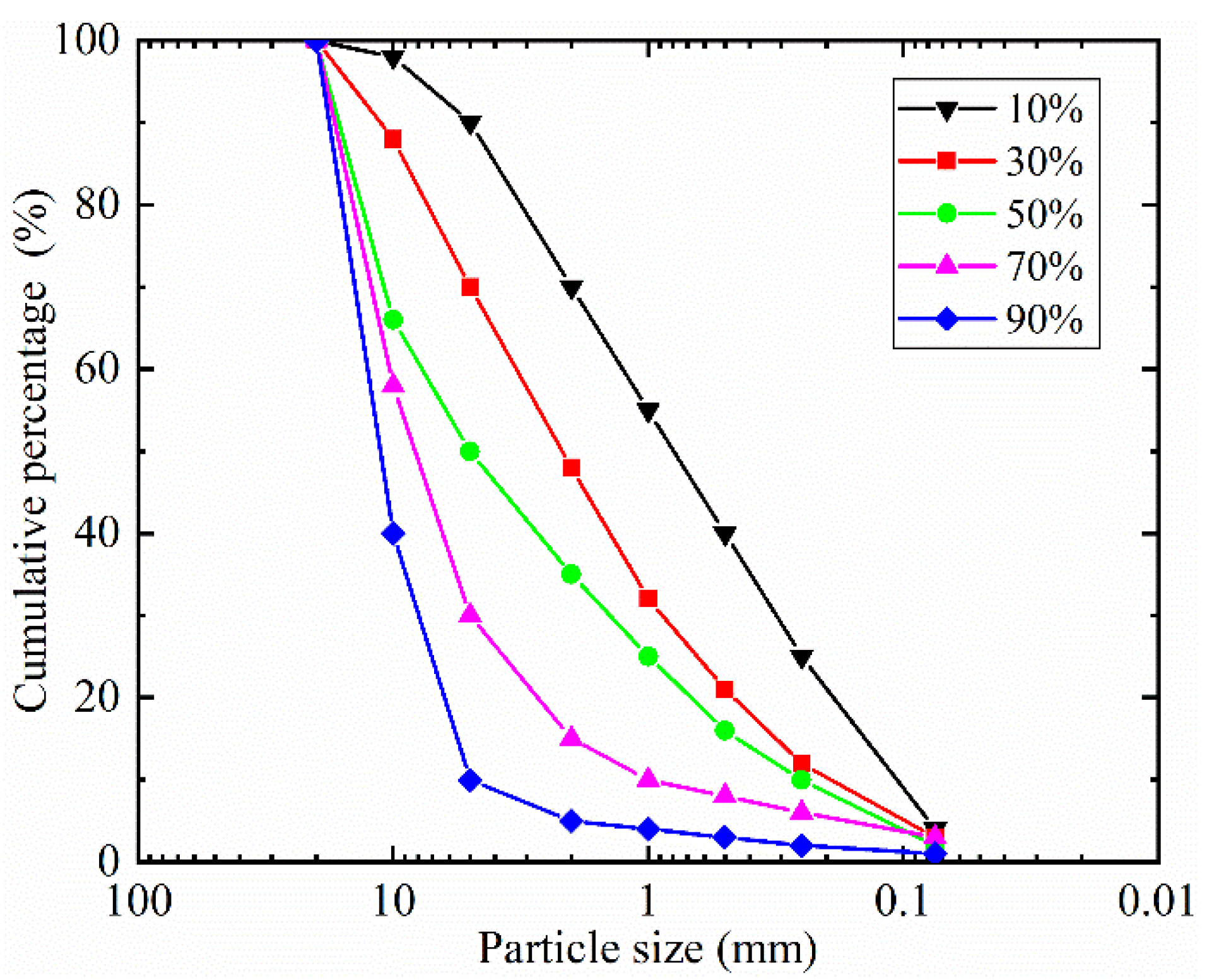


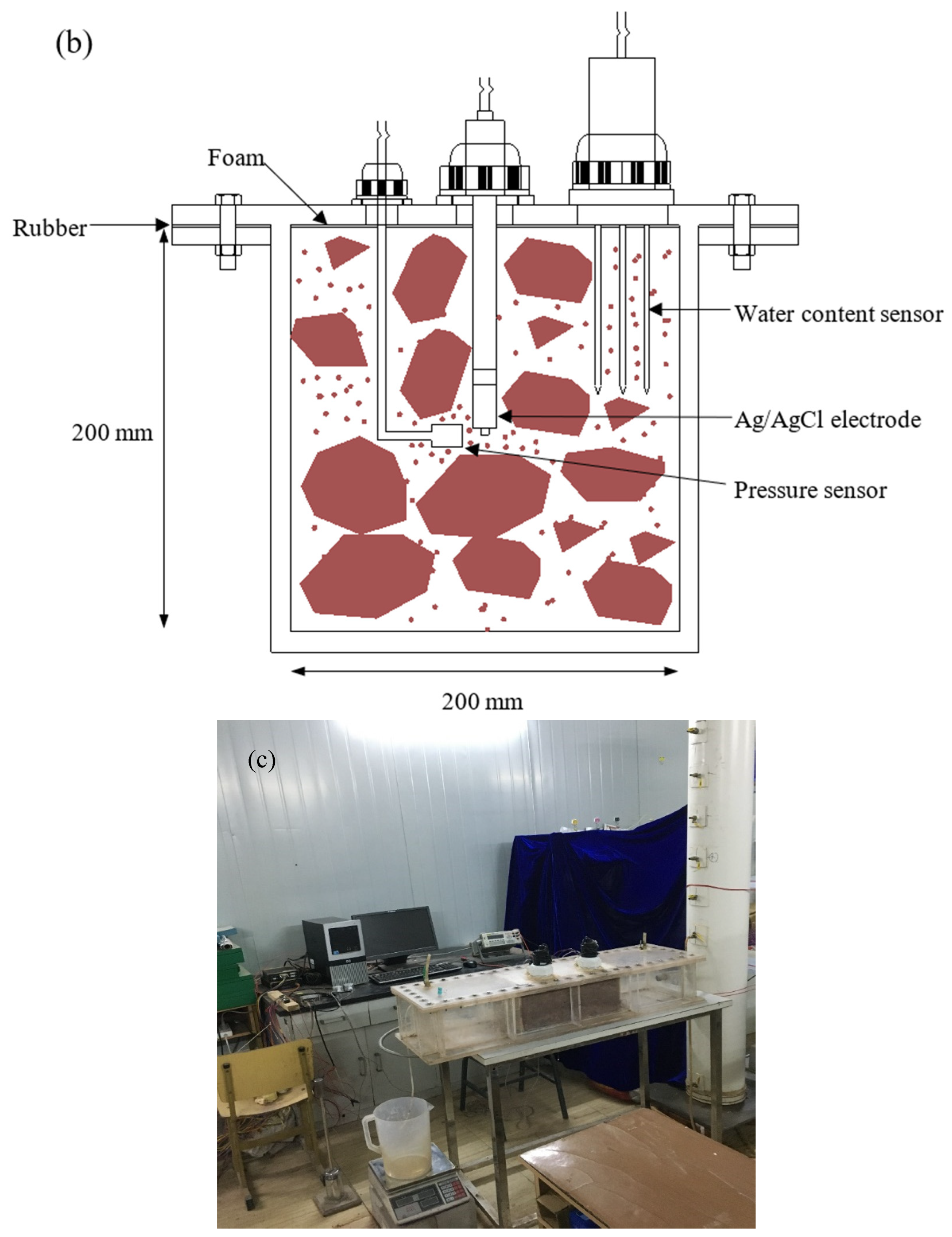
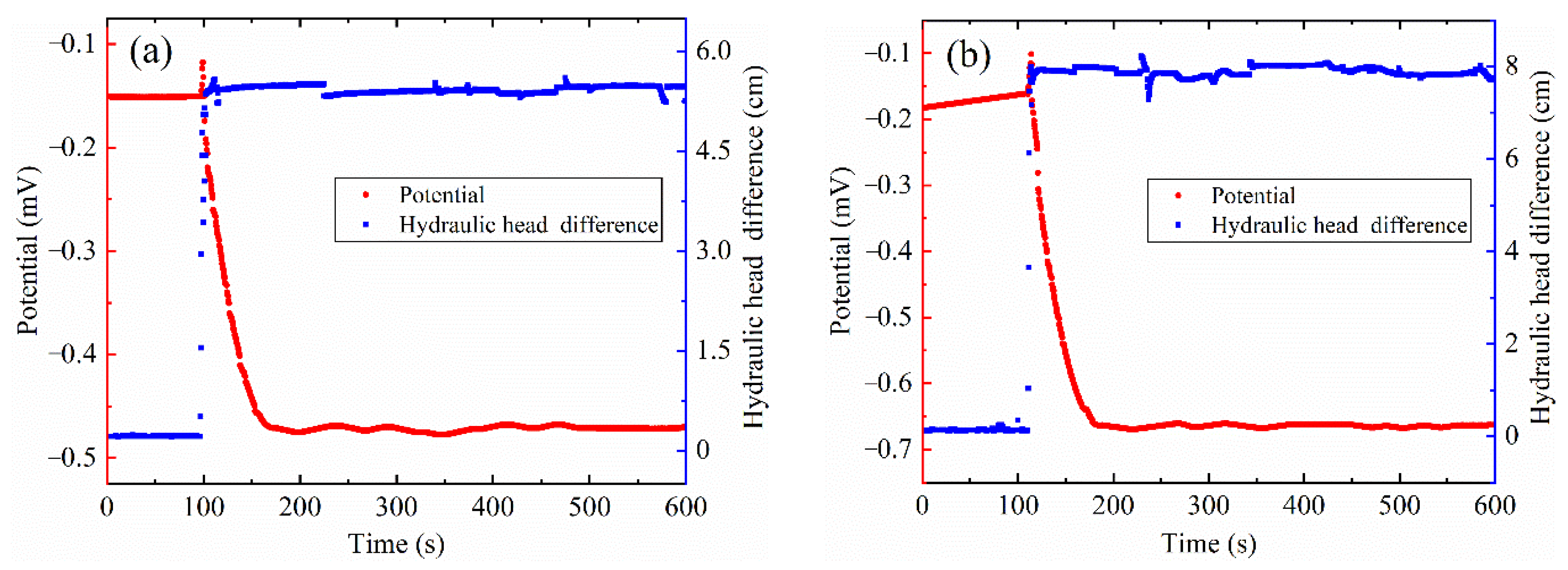
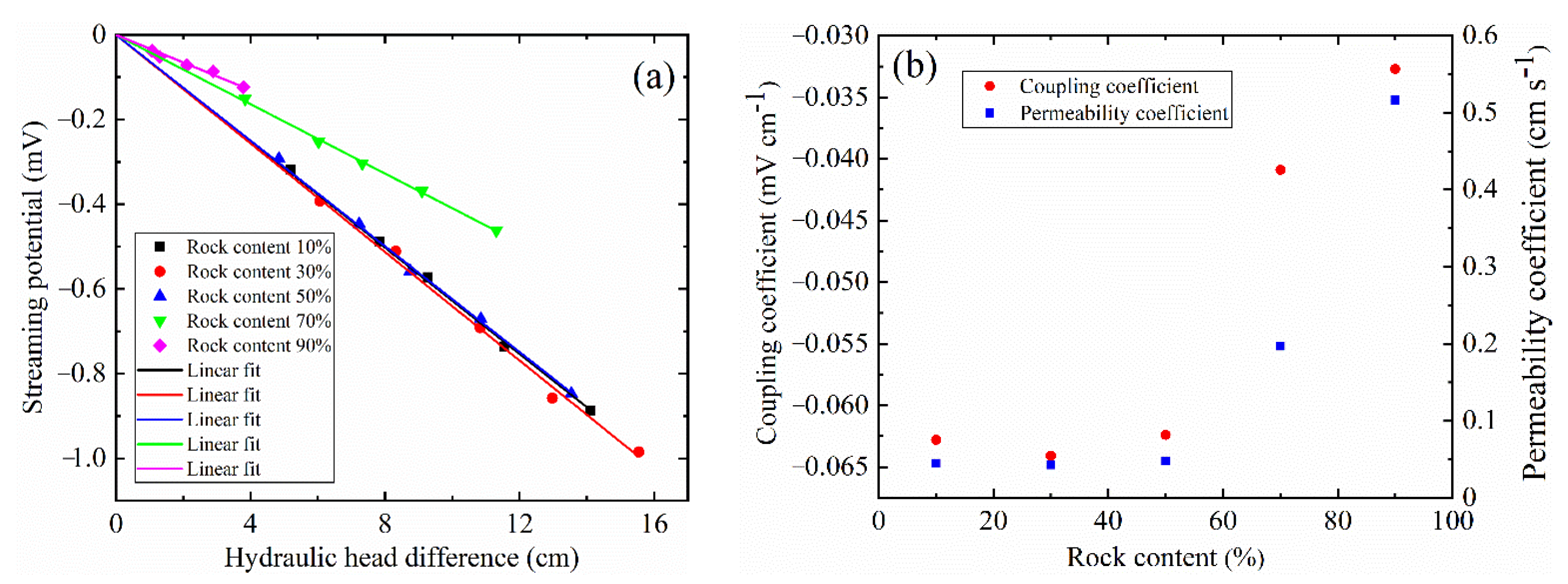
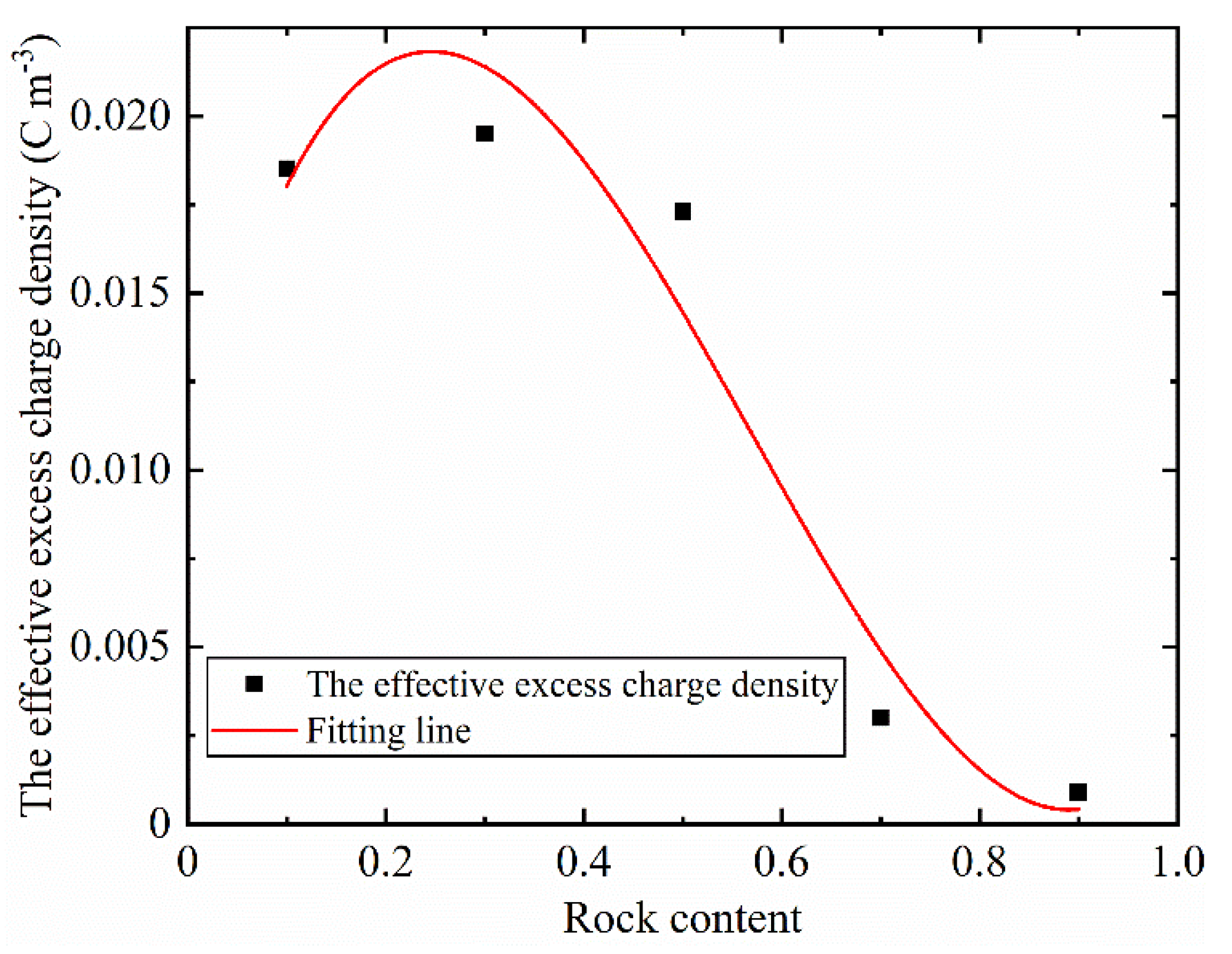
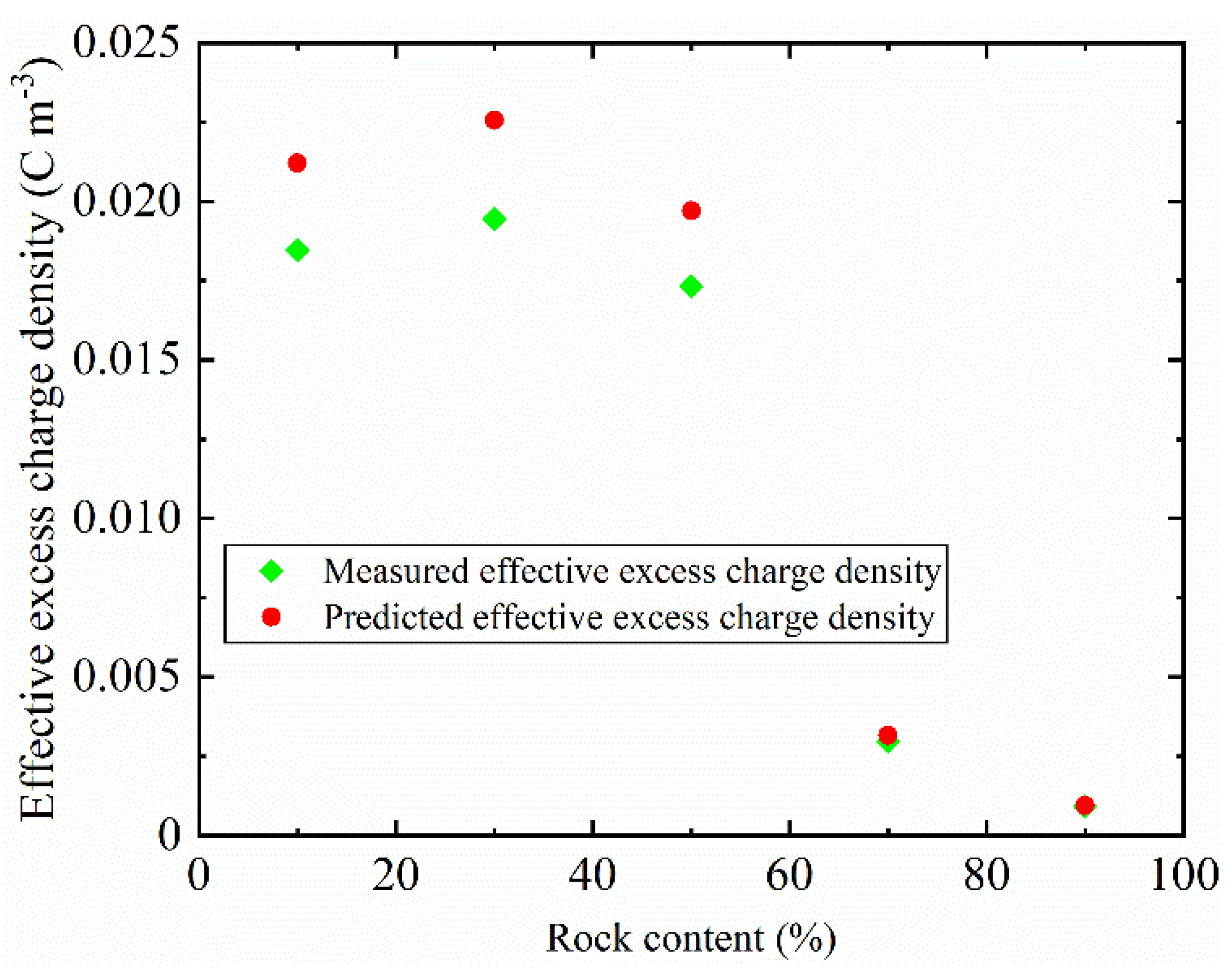
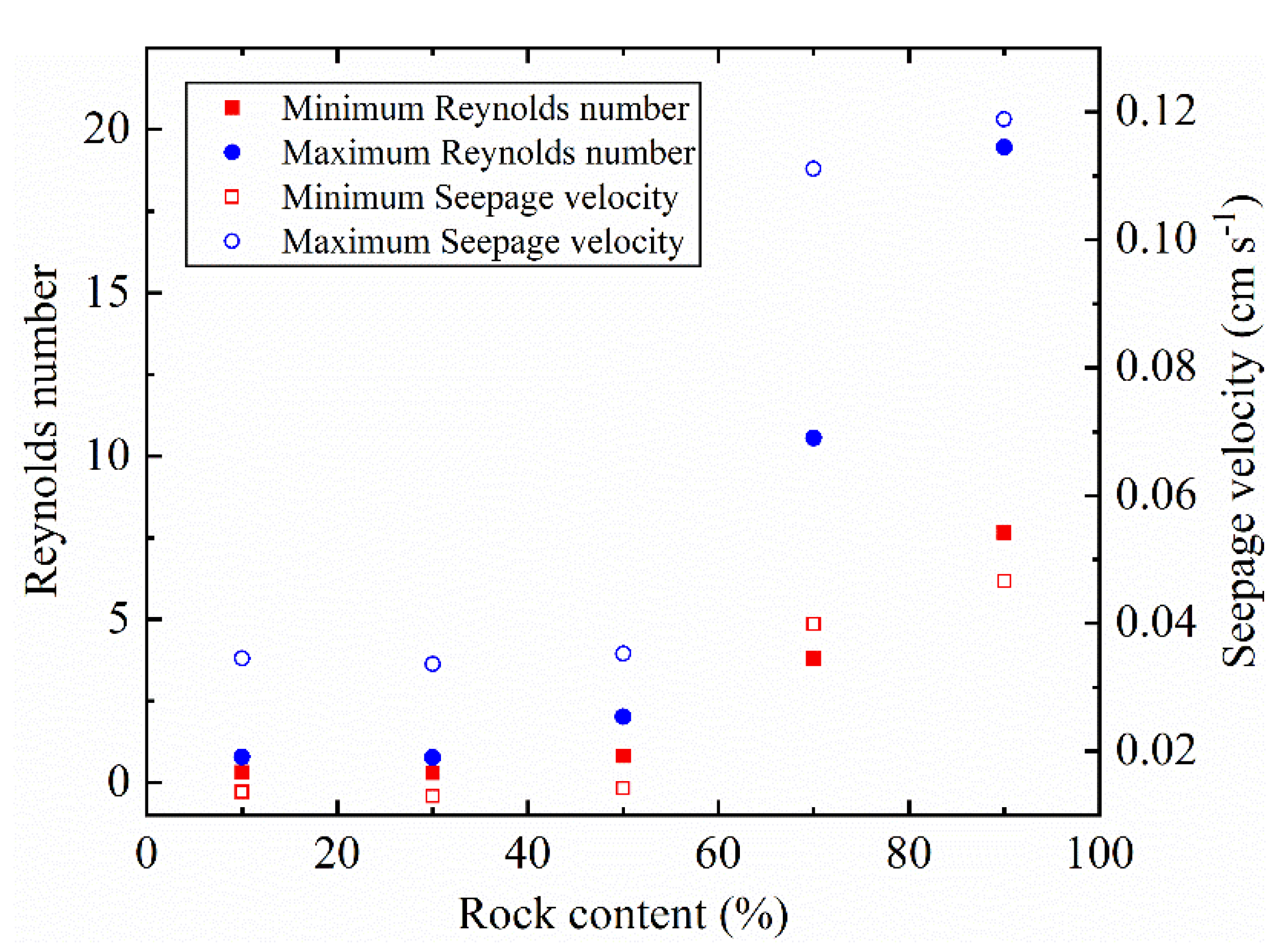
| Rock Content | 10% | 30% | 50% | 70% | 90% |
|---|---|---|---|---|---|
| Porosity | 0.32 | 0.30 | 0.30 | 0.31 | 0.30 |
| Temperature (°C) | 24 | 23 | 25 | 24 | 23 |
| Electrolyte conductivity (S m−1) | 0.089 | 0.088 | 0.087 | 0.091 | 0.089 |
| Sample conductivity (S m−1) | 1.35 × 10−3 | 1.33 × 10−3 | 1.36 × 10−3 | 1.45 × 10−3 | 1.48 × 10−3 |
| Formation factor | 66.86 | 67.02 | 65.16 | 63.54 | 61.32 |
| Dynamic viscosity a (Pa s) | 8.95 × 10−4 | 9.16 × 10−4 | 8.74 × 10−4 | 8.95 × 10−4 | 9.16 × 10−4 |
| Relative permittivity b | 79 | 79 | 78 | 79 | 79 |
| Zeta potential (mV) | −72.48 | −74.92 | −69.96 | −48.34 | −38.84 |
| surface conductivity (S m−1) | 1.24 × 10−3 | 1.25 × 10−3 | 1.59 × 10−3 | 1.41 × 10−3 | 1.69 × 10−3 |
Publisher’s Note: MDPI stays neutral with regard to jurisdictional claims in published maps and institutional affiliations. |
© 2022 by the authors. Licensee MDPI, Basel, Switzerland. This article is an open access article distributed under the terms and conditions of the Creative Commons Attribution (CC BY) license (https://creativecommons.org/licenses/by/4.0/).
Share and Cite
Zhang, X.; Zhao, M.; Wang, K. Understanding the Influence of Rock Content on Streaming Potential Phenomenon of Soil–Rock Mixture: An Experimental Study. Sensors 2022, 22, 585. https://doi.org/10.3390/s22020585
Zhang X, Zhao M, Wang K. Understanding the Influence of Rock Content on Streaming Potential Phenomenon of Soil–Rock Mixture: An Experimental Study. Sensors. 2022; 22(2):585. https://doi.org/10.3390/s22020585
Chicago/Turabian StyleZhang, Xin, Mingjie Zhao, and Kui Wang. 2022. "Understanding the Influence of Rock Content on Streaming Potential Phenomenon of Soil–Rock Mixture: An Experimental Study" Sensors 22, no. 2: 585. https://doi.org/10.3390/s22020585
APA StyleZhang, X., Zhao, M., & Wang, K. (2022). Understanding the Influence of Rock Content on Streaming Potential Phenomenon of Soil–Rock Mixture: An Experimental Study. Sensors, 22(2), 585. https://doi.org/10.3390/s22020585






